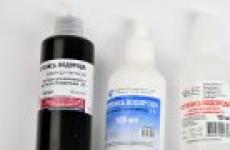Cold water is flowing. What to do if cold water flows from a hot faucet? Incorrect boiler connection
From the author: Hi friends! If you turned on cold water with a habitual movement, but boiling water suddenly poured out of the tap, it means that the matter is unclean. And in every sense, because you definitely won’t be able to wash in this state of affairs. The problem needs to be addressed, and quickly.
To save you from a lot of Internet queries in the spirit of “hot water flows from a cold tap for a reason”, we decided to bring all the information available into one article. Today we will look at why such situations can occur, and what needs to be done in order to eliminate them and prevent them in the future.
Causes of the problem
There are several possible reasons why hot or warm water started to come out of a cold water tap:
- incorrect wiring installation;
- mixer malfunctions;
- lack of a check valve installed in the water supply system;
- improper use of any plumbing equipment.
Let's deal with each item in order.
Incorrect wiring
This factor depends solely on the work of specialists who service your home. If, during the process of connecting the pipes, the wiring was connected incorrectly, then the water, accordingly, will go through the wrong pipe.

In such situations, the cause of the problem is obvious, since problems begin immediately after any global plumbing work is done in the house. These, for example, include the replacement of common house risers.
If immediately after such work, when you turn on the water supply, you find that the cold water has ceased to be cold, this is a reason to immediately apply to the management company. After that, specialists of the appropriate profile should correct the situation.
Faucet malfunctions
If the problem arose immediately after installing a new faucet, then usually the problem is that the fixing washer is not tightened correctly. In this case, the product must be removed and reinstalled.
But it also happens that the equipment has been serving for quite a long time, and only after that there were problems. In this case, the problem should be sought in the interior of the mixer.
At the heart of its design, two variants of the crane box are used. The first is metal parts and a rubber gasket. This is the last one that can cause problems. The material from which it is made is rather unreliable. It can become deformed, damaged or simply rot over time.
The second version of the crane box is two plates made of ceramics. They have holes just needed to adjust the mixing of cold and hot water. This device is more reliable than a rubber gasket, but it can also gradually wear out, losing its tightness. Then the involuntary mixing of hot water into cold begins to occur.

In both cases, there is only one way to solve the problem - replacement. Fortunately, not the entire mixer needs to be replaced, but only the damaged part of the structure. In the first case, this is a rubber gasket, in the second, the entire cartridge. In both situations, the replacement is quite easy, even a beginner can handle it. And the repair cost is very low.
The absence of a check valve in the system
Recently, this problem occurs less and less. This is due to the fact that almost all apartments now have water meters installed. They are registered by the management company only if there is a check valve, since its absence can make it possible to “twist” - that is, forcibly reduce - the meter readings.
But even if in one of the apartments located along one riser there is no check valve, then there may be problems with mixing water into the “wrong” pipe. The secret lies in the pressure difference. In a pipe with cold water, it is always lower than in another. The check valve installed on it prevents the outflow of water in the opposite direction, but its absence leads to the opposite consequences.
Thus, cold water is displaced by hot water and, accordingly, almost boiling water begins to flow from both pipes. The situation worsens in cases where the apartment, in which there is no non-return valve, is located on one of the upper floors.
If this equipment is not available in your apartment, then there is only one way out - to install it. The check valve can be supplied both separately and together with a meter to account for water supply. If everything is fine with you, then the problem is in one of the neighboring apartments.
You can find out the source of the phenomenon as follows.
- Pay attention to how the meter installed in your apartment works to account for cold water supply. If it spins in the opposite direction, then turn off the water with the stopcock and look again. In the event that the reverse movement stops, you can be sure that the problem lies precisely in your apartment, and in particular in one of the plumbing fixtures, which we will discuss below.
- If there is no meter, then turn off the hot water using the shut-off valve, and start cold water in the mixer. Then close the last one. Open the stopcock and feel the cold water pipe. If you feel that it is heating up, then you again have a problem. If not, then it's in the neighboring apartments.
- Now turn off the hot water shut-off valve again and open the cold one in the mixer. Wait a few minutes. When hot water finishes flowing from the cold faucet, touch the riser. If the problem is in one of the apartments located above you, then the upper part of it will be heated. And vice versa. Let's say right away that you should not instantly run to your neighbors with a scandal. Most often, they themselves are not aware that they are the source of such an unpleasant phenomenon, so you need to try to resolve the issue peacefully.
Now that we have dealt with check valves, let's look at what plumbing equipment can cause water to “squeeze” in pipes.
Incorrect use of equipment
Two types of equipment are most often the source of the problem: a hygienic shower and a water heater. The first is a shower head with a mixer, which are installed next to the toilet. This wonderful hygiene device is misused by many.

As a rule, the design of the shower includes locking elements, as well as a special button that is responsible for starting water from the watering can. To perform hygiene procedures, you must first open the tap, and then press the button.
So, after using the shower, many people only return the button to its original position, and the locking mechanism itself is not blocked. Water from the watering can stops running, but it is present in the mixer itself. If one of the neighbors turns on the cold water, the pressure in the corresponding pipe will drop, which will lead to hot water entering there.
There is only one way to deal with this phenomenon: always close the shut-off equipment after using a hygienic shower. Only in this way will you protect yourself and your neighbors from displacing cold water with hot water.
As for the boiler, here we again return to the issue of the check valve. If the latter is not present, then the already heated water from the device can go into a riser designed for cold water.
The consequences of this situation are not only mixing hot water into cold water, but also economic losses. In this mode, the boiler will work to heat a huge amount of water, that is, almost continuously. Imagine what the bills for the electricity it runs on will be.
Therefore, it is extremely important to observe two rules. The first is the installation of the notorious check valve. It must be mounted below the tank and locking mechanism.
The second rule relates to the operation process. In order to avoid displacement, which we have already written about more than once, before turning on the boiler, it is necessary to close the hot water supply pipe, as well as open the input and output valves related to the equipment.
When switching off, on the contrary, close the corresponding valve and open the shut-off valve on the pipe. Otherwise, overshoot will occur.
Summing up, we can say that the problem can be solved either by communicating with neighbors, or by contacting the management company, or by a slight re-equipment of the water supply system located in your apartment - this means installing a check valve if it is not there.
Possible consequences

It is not worth postponing the decision of the issue, as this can lead to unpleasant consequences. And we are talking not only about the inconvenience of using plumbing, when hot water is poured instead of cold. There are also more serious problems:
- the temperature of the water in a particular pipe is due to specially derived standards. They are based on the calculations of specialists so as to prevent the development of various pathogens in the water supply system. Many bacteria, for example, cannot live and multiply in cold and hot water, but they feel great in warm water. Thus, when mixed, ideal conditions are created for them. A multiplied colony of bacteria - for example, legionella - can cause unpleasant diseases. Moreover, it is not necessary to drink such water, it is enough to take a shower. Diseases can be quite serious, up to pneumonia, so the situation is definitely worthy of your attention;
- The second possible consequence is material damage. Some plumbing products are simply not designed for excessively high temperatures. If the water passing through them is too hot, this can lead to deformation of individual structural elements and, subsequently, to failure of the equipment itself. These, for example, include a meter for accounting for water supply, a toilet tank, and the like;
- the third factor is the responsibility for the life and health of other people. If, due to a malfunction in your apartment, one of the neighbors gets burned with hot water, then the blame for this will be solely on you. For some reason, some believe that the management company should be held responsible for such cases. But in fact, she is only responsible for the section of water supply that reaches the stopcocks located in your apartment. Everything after them is your business and your responsibility. Therefore, do not ignore the complaints of neighbors, even if at first glance everything is in order with your water supply. It is better to once again carefully check the operation of the system in order to avoid trouble.
Now you know that the flow of hot water from a cold faucet is not due to higher powers or insidious plumbers. Most often, the problem lies in the apartments themselves. Therefore, in the event of its occurrence, it is quite reasonable to announce a meeting of the owners of those dwellings that are located along the corresponding riser, and discuss the issue with them.
If you still can’t identify the source of the problem on your own, then it makes sense to call specialists from the organization serving the house. In any case, we are sure that after our article you will be able to successfully solve this issue. Good luck to you, and see you soon!
Poor water flow from the faucet
The weak pressure of water flowing from the tap is an unpleasant problem for a comfortable stay in the apartment. The reasons may be different. In some cases, you can cope on your own, and in some cases, you will need the help of a specialist or contacting the management company that serves your home.
Reasons for low water pressure:
- clogging or deterioration of the mixer aerator;
- clogging or deterioration of the mixer itself;
- clogging of the inlet flexible hoses;
- clogging of the pipeline;
- clogging of pipeline filters;
- decrease in water supply pressure in the plumbing system;
- pipeline depressurization, i.e. his breakthrough;
- improperly designed piping system.
 Eliminate weak water pressure from a faucet
Eliminate weak water pressure from a faucet Elimination of weak water pressure with your own hands:
- Clogged or worn faucet aerator it's not a big problem. We unscrew the aerator from the gander of the crane. We wash and clean the aerator mesh from plaque and debris. If the mesh is rotten, then a replacement is required. It is required to wash the aerator mesh every 2-3 months. It has small nozzles and therefore quickly clogs due to poor water quality. If the problem persists, then check further.
- Clogging and deterioration of the mixer itself also a common cause of low pressure. If the water does not flow well in only one place in the apartment, and the pressure is good in other faucets, then for sure the problem is only in this faucet. You need to turn off the water. Next, disassemble and clean the internal parts of the mixer from n. Also replace worn parts. There is a problem with the sprayer in the shower or in the bathroom. The holes on the sprayers are covered with limescale and water cannot flow with the required pressure. Limescale is easily removed with acid. Place the sprayer in a plastic bag with a solution of acetic or citric acid and fix the bag with electrical tape or tape for several hours. Rinse the sprayer after the procedure. It will be like new.
- Clogged inlet flexible hoses also easy to fix. It is necessary to disconnect the hoses with an adjustable wrench or wrench. And wash them. Next, we deal with the pipeline itself.
- Pipeline blockage more complex operation. Cleaning is carried out with a special cable. A lot of rust accumulates in old metal pipes, which can also cause poor water pressure. After cleaning, you need to substitute a bucket under the pipe outlet and turn the water on valve so that all the dirt in the glass is in a separate container. If the cause is a blockage in the common water riser, then this can only be solved by replacing the clogged section of the pipe with a new one.
- Clogged pipeline filters, if present, is also a common cause of poor water pressure. Filters are coarse and fine cleaning. We shut off the water. We remove the plug from the coarse filter flask using an open-end or adjustable wrench. Remove and wash the mesh filter. If it is worn out, then we change it to a new one. We collect everything in the reverse order. And we proceed to check the fine cleaning system. Disconnect it from the water supply, change the insert and rinse the filter glass from dirt. Also assemble the filter in reverse order.
- Reducing the pressure of the water supply in the plumbing system this is an external reason. If the neighbors also have a weak water pressure, then you need to call the management company and report the problem.
- Pipeline depressurization, i.e. a pipeline rupture can also be solved only by the management company.
- Incorrectly designed piping system maybe if you always have low water pressure. This issue also needs to be resolved with the management company.
Constant and timely maintenance of plumbing fixtures will minimize the occurrence of such problems.
If warm water flows from the tap in your apartment instead of hot, it is not only uncomfortable, but, above all, unsafe for health. We advise you to immediately address the problem. Don't know who to contact and how to file a complaint? Read our material.
If, instead of hot water, barely warm water flows from the tap, write a complaint to the management company.
Photo: Anton VOLK
What temperature should the water be?
At the legislative level, standards have been adopted for the temperature of hot water. Thus, paragraph 2.4 of the Sanitary and Epidemiological Requirements and Rules 2.1.4.2496-09 establishes that the temperature of hot water in the places of water intake (washbasin, shower, etc.) should be from +60 ° C to +75 ° C. It is these indicators that provide protection from the spread of certain infectious diseases.
Why is warm water dangerous?
Warm fresh water is a comfortable habitat for harmful bacteria, including legionella. Legionellosis, or Legionnaires' disease, is a rare type of pneumonia. In Russia, an outbreak of pneumonia was recorded in 2007 in the city of Verkhnyaya Pyshma, Sverdlovsk Region. Then the doctors suggested that the virus could have been introduced through the hot water system. More than a hundred people were hospitalized, several infected people died.
By the way, the effect of temperature on the state of bacteria, in particular legionella, is as follows: at +70−80°С water is completely disinfected, at +66°С the bacterium dies within two minutes, at +60°С death occurs within 22 minutes, at +55°С - within six hours, and at +20−45°С active reproduction of bacteria begins. At temperatures below 200C, complete fading occurs. That is why the above requirements for water temperature (+ 60-75 ° C) are designed to solve several problems. It:
Prevention of the development of bacteria and viruses in water that live at lower temperatures.
Minimizing chloroform in water that has been chlorinated.
Prevention of diseases of the subcutaneous tissue and skin.
To whom to complain?
If the temperature regime is violated, first of all, it is necessary to document the fact that the hot water parameters deviate from the requirements of SanPiN. Unfortunately, utility workers will not come to measure the temperature of the tap water themselves. It will be much easier to install meters with a temperature sensor. But you can use the simplest way - to independently measure the temperature of the water.
Important! The data obtained will not be evidence for public utilities, only a reason to contact the relevant services. It is necessary to act as follows. Open the mixer and let the water drain (about 3-5 minutes), fill a small dish (for example, a glass jar) to the brim, lower the household thermometer into the container and evaluate the readings after a few minutes.
If the value obtained by self-measurement on the thermometer scale is below 60 ° C, an application-claim is submitted to the dispatch service of the management company or the housing and communal services department. The appeal must be recorded in writing, indicating the address, time, application number and the name of the receiving employee. A similar claim is written in the opposite situation, if, for example, hot water runs instead of cold water or cold water does not correspond to the norm. In some cases, a drop in temperature occurs as a result of a technical malfunction. At the same time, the dispatcher must inform the applicant about this fact and indicate the terms for normalizing the temperature regime.
In the absence of objective reasons, the time of arrival of a specialist to the territory of the tenant is agreed upon for measurements. According to paragraph 108 of Decree No. 354 of the Government of the Russian Federation, the verification must be carried out within a period of no more than two hours from the moment the application was submitted. A longer period may be set by mutual agreement. Based on the results of the study, an act is drawn up in several copies, one for each participant in the process. If the results of the check do not suit the consumer of services, he may require an examination. The procedure with the participation of an expert is agreed in advance on the time of its implementation. The results are also recorded in the act.
Need to know! Although the cost of re-parsing is borne by the contractor, if the temperature in the hot water supply (DHW) system is found to comply with the standards, the applicant will have to compensate for these
expenses.
If a utility employee refuses to leave for an inspection, the act is drawn up by the residents. Signatures on the document are put by at least three representatives, while family members or neighbors can be involved. An act received by any of the above methods is used as a basis for recalculating the cost of services rendered and imposing a fine on the person who committed the recorded violation. The period for which you can claim a reduction in payment ends on the date the violation is eliminated. If the water in the tap did not get hotter, the second check was not carried out, then the term for the provision of services of inadequate quality will not be completed. This should also be mentioned in the requirement. In addition, you can demand a recalculation even if there is no hot water at all. In this case, the refusal to recalculate from the management company is not legal. In this case, you can send an application to Rospotrebnadzor, the prosecutor's office or the world court.
Obtaining services of appropriate quality is a legitimate requirement of every consumer. And by “poor quality hot water,” we mean not enough hot water, regular shutdowns, and poor pressure.
Such a household appliance as a water heater is very popular. Convenient and undemanding in maintenance, it has found its application both in private houses and in apartments. However, not everything is as smooth as it might seem, and sometimes the owners are faced with incorrect operation of the equipment. The reasons for the fact that, for example, hot water does not come out of the boiler when the tap is opened, may be different. In the event of a problem, do not panic and change the device to a new one, in most cases, breakdowns can be repaired.
Water heating equipment of a flow or boiler type can fail for many reasons. Here it is immediately worth warning that it is better for a user inexperienced in these matters to turn to professionals for diagnostics and repairs. Otherwise, there is a great risk of irrevocably spoiling expensive equipment.
Possible causes of malfunctions:
- hard water with an abundance of harmful impurities;
- breakage or burnout of wiring;
- improper installation of equipment;
- gross operational errors.
It is quite easy to identify problems with the heating element: if the heating element is covered with a thick layer of scale, then normal heating is out of the question. Most models are equipped with emergency cut-off switches that turn off the equipment at the time of overload. The latter can just be caused by scale on the heating element.
Another reason for a decrease in heater output is a breakdown of the electronic board. It is necessary to carefully examine it for physical damage, as well as check the performance of the diodes. They must be active when the equipment is heating water. There can be two options here - the light is on or does not show signs of life.
Diode active
If the indication works properly when the boiler is turned on, but the water does not heat up, then this indicates failure of the heating element. To verify the malfunction, it is necessary to remove the element and ring it with a multimeter. If the device points to infinity, it means that a break has occurred somewhere, while zero is a sign of a short circuit.

Another point signaling the need to replace the heating element - protection activation, which turns off the boiler immediately after switching on. Here it would also be useful to ring the heating element with a multimeter to make sure 100% of its malfunction. If the automation does not work, and the element barely heats up, then you need to clean it and try to start it again. In difficult cases, simply change the old heating element to a new one.
Diode does not light up
Using the same multimeter, you need to check Is there voltage to the thermostat?. We call the board with the thermal protection running. If there is voltage, then we remove the thermostat and diagnose the equipment by input-output, not forgetting to change the modes on the thermostat.
If there are no phase movements, then the board will have to be changed. In rare cases, it can be repaired, but it is much more practical to buy a new module than to spend a lot of time and nerves on restoring the old one.

Thermostat check
Filter clogged
The inlet part of the water heater passes through itself large volumes of water. To protect the internal parts of the device from foreign elements and water debris, the design provides for the installation coarse filter. Due to the nature of its operation, the filter is subject to periodic contamination. Rusty pipes, dirty water form dense formations on the mesh gasket that interfere with the flow of fluid.
The malfunction is eliminated after thorough cleaning under running water. For this you need:
- unscrew the cap of the flask using a special key;
- remove the mesh gasket and eliminate contamination;
If the blockage is too dense, you can use dishwashing detergents. Do not leave the mesh soaked in a solution with a product, just apply it to a sponge and wipe the part. After that, you need to install the filter in place, repeating all the steps in reverse order.
To prevent clogging in the future, experts recommend purchasing an additional filter.

Coarse filter
Faucet contamination
Liquid will flow in a trickle if mixer spout congestion has occurred. The pressure will be equally bad for both cold and hot water. To fix the problem, you need to carry out a number of procedures.
- Close the riser to turn off the water.
- Remove the mixer carefully.
- Unscrew the spout from the common body.
- Remove the mesh and rinse it under running water. In case of formation of salt deposits or dense dirt, let it soak in a special cleaning solution.
- Rinse the mixer spout thoroughly and clean the insides of dirt with a brush.
- Reassemble the faucet in reverse order and reinstall it. Don't forget to open the riser.

This procedure may take some time, as an alternative, you can simply replace the clogged mixer with a new one. Experts recommend replacing worn parts every few years to avoid serious breakdowns in the future.
A filter system installed on the pipes connecting the system to the water heater will help to avoid further contamination.
Cleaning the heating element
Commonly used in water heaters open type heating element. One of its features is the need for regular cleaning. It must be carried out at least once a year, otherwise salt formations can block the hole intended for the flow of fluid from the pipeline. In addition, excessive scale formation can generally disable the heating element. In order for the flow of hot water from the water heater to go well, do the following:
- dismantle the protective cover;
- carefully disconnect the wiring connected to the heating element;
- pull out the heating element and carefully descale it by placing it in a solution of citric acid;
- thoroughly wash the inner walls of the storage tank;
- check the integrity of the magnesium anode, if necessary, replace it with a new one.

Replacing the heating element
If the heating element is still burned out, it must be replaced with a new one. Water heating equipment is presented on the market in a wide range, but the location and principle of replacing the heating element in a good half of the cases is the same. For the same boilers from Ariston or Electrolux, the whole procedure takes place like a blueprint.
To extract the heating element you will need:
- a set of cap and open-end wrenches;
- pliers;
- Phillips and flat screwdrivers;
- probe with indication.
Before dismantling the heating element, the equipment must be completely de-energized: not only by turning off the boiler with the button, but also by pulling the plug out of the socket.
Replacing the heating element:
- Shut off water access to the heater.
- We remove the remaining liquid from the boiler through the local drain system (hoses, valves).
- If the model is wall-mounted, then it must be removed.
- We dismantle the panel under which the heating element is located. Sometimes the lid is one and closes the entire structure.
- We check with a probe if there is any residual voltage at the terminals.
- We loosen the fasteners of the heating element and remove it.

When dismantling, it is important that no moisture gets on the electrical parts. It will also be useful at the same time inspect the gaskets on the pipes and check the condition of the insulation: Tighten and replace if necessary. The new heating element is mounted in the reverse order. Before switching on, be sure to check the boiler for leaks.
Thermostat replacement
Before dismantling, be sure disconnect equipment from the network. We disassemble the boiler according to the instructions above up to point 5.

Dismantling elements
Thermostat replacement:
- Loosen the clamping ring next to the heating element.
- We take out the adjustment unit along with the thermostat sensor.
- We mount new elements.
- We assemble the structure in the reverse order.
After replacing parts, the equipment must not be turned on immediately. To get started you need make sure that there are no leaks and a stable flow of water. If necessary, we release the accumulated air in the system. After turning on the temperature with a thermostat, we raise it smoothly, without sudden jumps.
Fork gets hot during operation
Boilers are quite powerful equipment, consuming an average of 1 to 2.5 kW. Therefore, slight heating of the fork can be ignored. If the temperature of the cable is very high and close to melting, then, first of all, it is worth changing the carrier to an adapter with a large wire cross section.
Plug dangling in socket can also cause a rise in temperature. If only the plug heats up, then the problem may be in poor contact of the wires. In the case of a collapsible system, everything is simple: we open, inspect and eliminate the cause. The whole fork will have to be completely changed.

Another possible source of problems is the breakdown of the heating element, and, as a result, a short circuit with the case. As a result, the wires begin to melt, and the equipment loses power. To eliminate the malfunction, it will be necessary to disassemble the boiler and replace the heating element.
Other reasons
Below we describe less common malfunctions in which water at the desired temperature does not flow from the water heater.

As you can see, most problems can be successfully repaired at home. However, it is better to call a specialist who can provide professional assistance.






